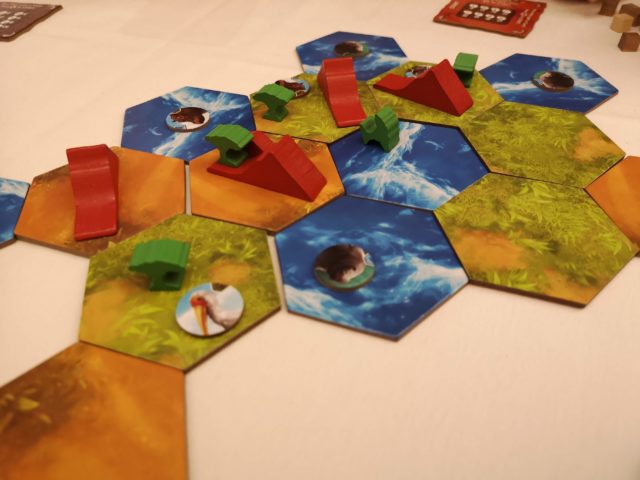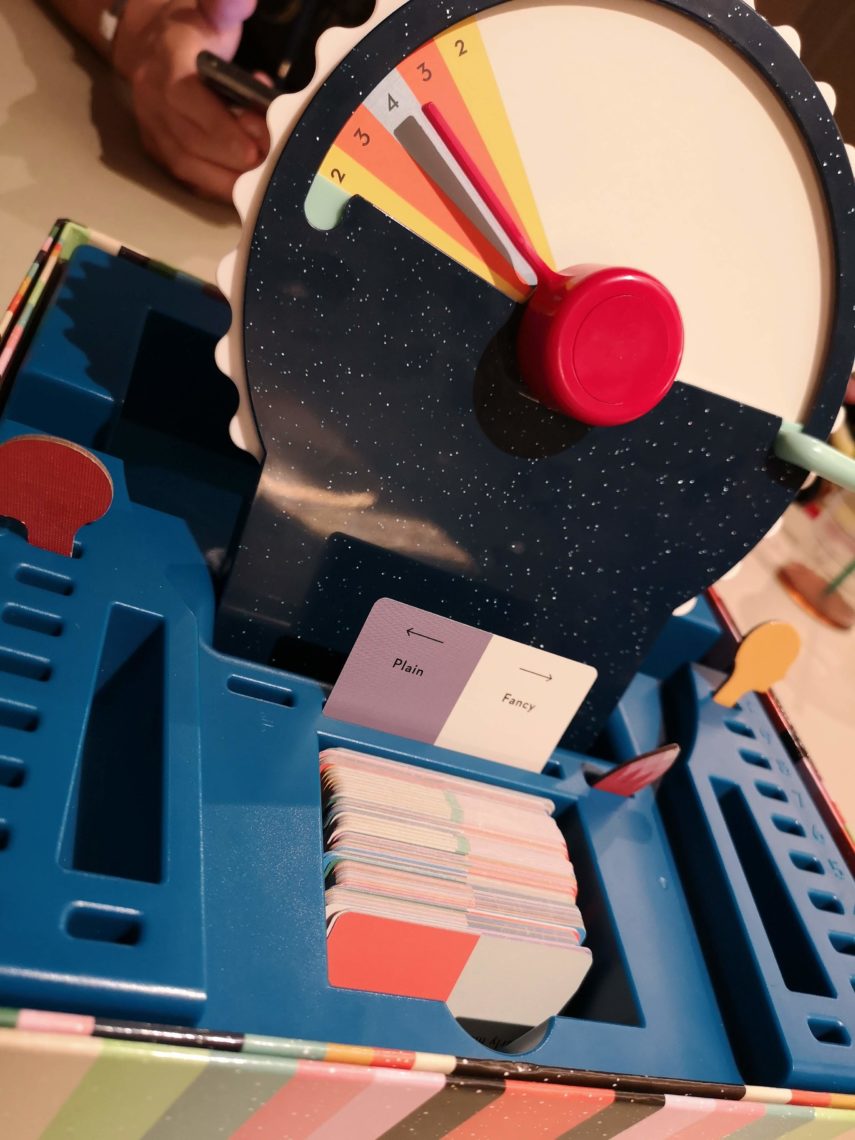This year was the big debut of BGGcon Fall’s new bigger & better venue, which was quite the change to get used to. These much nicer, more up to date digs were a refreshing change and really enabled BGG to spread out throughout the facilities. Hot Games was given its own room, leaving the larger ballroom for strictly open gaming use. While other smaller boardrooms weren’t being used for special events, they provided extra open gaming space. I have to admit, I miss a lot of the smaller rooms you could escape to at the old venue — there were some at the new venue but many were set aside for specific use or always packed (so, the “quiet” room wasn’t exactly that!). Overall, I thought it was a great move – more space for exhibitors, great flow for the library and plenty of seating for everyone. I also really appreciated the shortening of the closing ceremony, as it meant more time for gaming!
The logistics aside, the con itself was great. This is my very social convention each year, a sort of board game summer camp where I get to catch up with gamers I’ve met at other events, through social media or like-minded content folks. This makes it difficult to game with everyone, but I managed to get around! My aim to get a couple of the heavier games in the Hot Games room was thwarted, but it led to me getting to try a few other things in there at least! I’ll give the run-down of those, plus a few other highlights of what I managed to try. My list may not be representative of the con overall, but it was a great slice of gaming.

My first hot game was Ecos: The First Continent, and although I’d played it once before, it was great to sit down and give it another whirl. I was handily whooped by friend of the DWP Eric Lang, even with his nonsense manatee strategy. If you’ve ever tried Rise of Augustus, which sort of flew under the radar after initial interest, then you’ll be into Ecos. A little bingo, with a little terrain building action, makes a great package. Diving into the ocean, I then tried my hand at Aquatica – I was a little surprised to have not heard of this one at all! It ended up being a really fun and interesting engine builder set in an underwater kingdom, players selecting actions using a small deck that can be built up – not unlike Concordia.

On the lighter side of things, while waiting for a table of Azul: Summer Pavillion to open up, I got in a couple of rounds of Die Crew (or, The Crew: The Quest for Planet Nine). This Kosmos title is only available in German right now, but I hope they get it out in English quick smart (I’ve heard the first half of 2020). This small sample whet my appetite for what seems to be a really challenging and fun coo-operative trick-taking game. In fact, friends that I ran into who had their own copies were seemingly playing it non-stop and the library copy ended up moving into the hot games room. I think I wouldn’t have had a chance to get to it, otherwise. When the newest instalment of the Azul trilogy became available, I sat down to a four-player game. While the 2nd Azul really fell flat for me, this was far more engaging and interesting. Not only are the tiles a very satisfying shape to lay out, but the way of scoring and getting bonuses was a great way to drive your gameplay. To place on a value of a spot, you have to have at least that one tile, plus the balance to discard into the tower — similar to the original scoring, but happening immediately. There are also bonus tiles to be had when completely surrounding certain parts of your player board. I’m looking forward to trying this a few more times – and we’ll see if I ever feel the need to have more than just regular ol’ Azul on my shelves.

Stepping outside of the hot games room, I got in a good number of games that I’d had recommended to me. The one I’d been looking forward to the most was On the Origin of Species. As a little bit of a Darwin nerd, I went into this with some enthusiasm and unknowing of any of the gameplay. It’s a pretty cool set collection game, with some spatial elements, and the timer of the game is the route of the Beagle which weaves around the board. Those looking for a more “sciencey” game might be disappointed, but I enjoyed it thoroughly and the theme definitely helped there! I appreciate Netters (of Nettersplays) and Mitch introducing me to this!

T from HABA had told me that Miyabi was definitely worth trying, as had others – and while I didn’t get to sit down and play with them, I did get a hold of another copy and learned it fairly quickly. It’s a lovely light tile drafting game, with some strategic stacking (not unlike NMBR 9!) to score points. The spatial elements of the game were fun and not too frustrating – each row of your player mat can only have plain grass tiles or the icon that matches; each column can only have one tile placed in it during the round. So, it’s quite a dance between drafting, ideal placement and points-getting. It is absolutely spot-on a family-weight HABA game, and I hope folks make a point to try it.
Another game that I’d managed to miss hearing anything about – and another introduced to me by Netters! – was Trails of Tucana, a new flip ‘n’ write from the designers of Avenue. There are some similarities in the route-building to connect particular locations on the map (with bonuses for beating others to it) – but there’s some periodic scoring by managing to connect either one or two special icons to cities, as well. It plays super fast, and I could see getting in a few games back to back. I know the market feels saturated with this genre right now, however it is a well-designed game that doesn’t feel as abstract as many others.

I’ve brought up Oink Games in the past, as their tiny packages that provide enormous entertainment are among my faves. One of their newest is Tricks of the Phantom – an extremely streamlined deduction game. All players will have a hand of numbered cards, and play one face down — the highest card will win (pending some cards with special powers). Before revealing, everyone takes a look at what they’ve got and attempts to deduce what others may have played and marks who they think will win with an adorable little magnifying glass token. The brain-bending is great fun, and it always felt so satisfying to get away with being the Phantom (that is, folks picking you as the winner when you’re really the lowest number – and you get to steal points from them – ha!).
Towards the light-hearted party end of games, two stood out for me. The first is Pictures, a strange hybrid of charades and drawing games and Codenames if I had to try and categorize it! A grid of images is laid out on the table, and every round a player secretly takes a co-ordinate that allocates an image to them. They will then have to use the resources available to them that round to create something that will – hopefully! – allow other players to guess which picture they’re referring to. These resource sets are two shoelaces; building blocks; coloured cubes with a 3×3 square to arrange some in; a deck of icon cards; and 4 sticks and some smooth stones. Yes, this is madness and it’s great. The idea of breaking down the complexity of an image into these simple elements is amazing, and the challenge is really fun – and oh man it’s satisfying when someone gets what you’re aiming for! Designer Elizabeth Hargrave was playing with us at a meetup I was at, and we were weirdly in-sync with the way we created our images. That was one of the more interesting aspects of this game – seeing how people would reduce an image down and what elements they felt were the most important. I highly recommend this one!

Lastly, Wavelength, a social guessing game, was out on tables constantly during the con! I played this a couple of times with different groups of people – and like any party game, it is interesting to see how play varies between groups. Breaking up into teams, each alternates between being the clue giver/guessers and the assessors of if the clue seems to be on the right track. The clue giver secretly spins the scoring wheel, which just has one small wedge of points — where that lands is where on the scale of “one thing to another” the clue giver needs their guesser to point to. Of course, that scoring wedge is hidden for the guessers, and it’s the strength of a clue to guide them the right way. Once the final decision of the dial’s placement has been made, the other team can say if they think the real answer is to the left or right of that – if correct, they’ll end up with a point! If the guesser ended up on that wedge of scoring, they’ll get whatever they landed on (2, 3 or the magical dead-on 4). For instance – if the two options to guess between are “light” and “dark” and the scoring wedge is slightly closer to the dark end of things, perhaps giving a clue like “latte” might work – not super light, but a little dark. It’s quite a feat to craft a clue that will be just right, and it’s a blast. I know this is heading out to Kickstarter backers now, I hope it’ll hit retail too.
There were, of course, other games I played, but these stood out as the newer things that I enjoyed. I was thrilled to be able to introduce folks to other “new-ish” games like Silver & Gold, 5211 & Cartographers between games and events, and I’m glad I chose those to throw into my backpack for the con! In return, I was treated to this hilarious late-night re-creation of what a “Watch It Played” for Cartographers might look like – thanks to Ross (More Games Please) for capturing this golden moment. Other than games, it really was a wonderful experience to be around all these folks and spend time with friends either heading out for meals (so much easier in the new location!), meeting the hotel dog “Leo”, or even packing into a hotel room to watch The Good Place together. This really is an outstanding time. See you next year, Dallas!
Comments
No comments yet! Be the first!